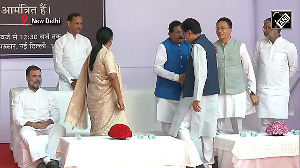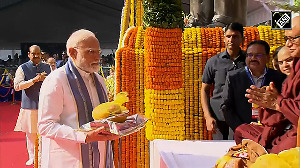Bhubaneswar's imposing secretariat looked as though it was under siege. Gun-toting policemen scrutinised visitors before they were allowed in. The cops swooped down on over 200 protesters who were preparing to go on dharna.
Special forces were moved in to the airport and in the hotel where the guests from Korea had arrived. Orissa's dapper chief minister wasn't taking any chances with the 30-odd senior executives who had come from Posco, the Korean giant steel maker, to sign a controversial agreement with the state government after a year of hectic negotiations and stiff opposition from domestic steel makers and political parties.
Posco, of course, is offering attractive goodies. In what is the largest foreign direct investment in the country, it will fork out over Rs 50,000 crore (Rs 500 billion) to set up a staggering 12 million tonne steel plant in the state.
Orissa's minister of steel and mines, Padmanabh Behera, is tom-tomming other benefits: the state will get a revenue of Rs 700-800 crore (Rs 7-8 billion) annually from the project. Besides, it will employ 48,000 people directly and indirectly.
And the central government will earn an additional Rs 89,000 crore (Rs 890 billion) in tax revenue over the next three decades.
But it has also been able to muscle in equally attractive concessions which are in the eye of the storm: Posco can export 30 per cent of the 600 million tonne iron ore reserve which it has earmarked for its plants in Korea.
Says an agitated Moosa Raza, president of India Steel Alliance, which represents the country's leading steel makers: "This is blatant discrimination. We are giving away scarce resources to foreigners so they can make steel cheaply, while we are being denied the same resource. It's xenophobia."
But Posco top brass is asking for public support and promises dramatic changes. "We will develop Paradip port in the same way as the company had changed the face of Pohang in Korea," says the India head of the Posco project, Tae-Hyun Jeong.
But that isn't likely to keep political parties asking for Naveen Patnaik's scalp quiet. Points out CPI leader A B Bardan: "It's nothing but unrestrained plunder of ore."
Bardan is pushing for an all-party meeting to chalk out the next course of opposition. And in a memorandum written to Prime Minster Manmohan Singh by Left leaders, Bardan has accused him of losing over Rs 96,000 crore (Rs 960 billion) in the deal.
How? Patnaik could have asked Posco to buy iron from the marketplace, he says.
But why are domestic steel makers up in arms? The reason is their desperate search for control over iron-ore leases, which constitutes 30 per cent of the cost of making steel. Its assured availability and control over the price is key for steel companies to remain in business.
But Posco, which has been promised large mining reserves not just for captive use but also for exports, has caused panic among existing steel makers because it means less iron-ore available for them.
Other proposed projects too have come under scrutiny. The country's steel makers have voiced their displeasure about a proposal by the Lakshmi Mittal group to set up an eight-10 million-tonne plant in Jharkand.
Says a senior executive of a steel company: "They will use Posco as a precedent to export iron ore for their own plants across the globe."
The gold rush for iron-ore follows its insatiable demand in China. Prices of iron-ore went up three-fold in the last 12 months. In India, most steel makers including Essar, Ispat, Jindal (controlling between them about 60 per cent of the production) do not have captive mines on lease.
They depend entirely on iron-ore available at market prices either through imports or from state-owned mining companies. With iron-ore prices on an upswing, they are desperately seeking mining leases without which they could well become unviable.
(While the market price for iron-ore has hit Rs 2,500-Rs 2,600 a tonne, the cost of extracting it from a captive mine is a mere fifth of that cost.)
State governments in Orissa, Jharkhand and Chattisgarh are offering mining leases -- but on one condition: The companies must put in greenfield steel plants in the state, and the iron ore cannot be taken out for steel plants in other states.
The Jindal group, for instance, has a proposal for a 5 million tonne steel plant in West Bengal with the mining facility in Jharkand. The project got blocked because Jharkand is willing to give mining rights only if the steel plant is also located in the state.
Most private steel makers are located in consuming states (Essar in Gujarat, Jindal in Karnataka, Ispat Maharashtra). Even so, they have signed agreements for new steel plants in these states for access to iron ore mines in the long term.
|
THE STEEL RUSH | |
|
Jindal Steel and Power |
2 million |
|
Tisco |
6 million |
|
Essar Steel |
4 million |
|
Posco |
12 million |
|
Tube Investment India |
1.2 million |
|
Jindal Stainless |
1.6 million |
|
Others |
17.51 million |
|
Total |
44.31 million |
But a big deal like Posco could dramatically change the scenario. Domestic steel makers allege that with the Koreans being assured iron-ore, there might not be enough mines left in Orissa for domestic steel makers, as reserves are limited.
Or, they might get iron-ore mines located in the deep forests which would be difficult to mine. Says a worried Jitendra Mehra, director in the Essar group: "The Posco deal will crowd out Indian steel makers from the market."
State government officials insist the fear is unwarranted, that they have enough iron-ore for the 36 companies that have signed MoUs with the Orissa government to set up steel plants and that they will all get mining leases for 25 years.
Says steel and mines minister Padmanabh Behera, "No project for which an MoU has been signed is going to suffer. We have free ore reserves of 2 billion tonnes, and of the 2.8 billion tonnes already pledged to various parties, a sizeable portion is with state-owned Orissa Mining Corporation (OMC) which can supply ore to different industries."
The domestic steel makers claim that's bunkum. "If all the proposed steel plants come, they will produce about 45 million tonnes of steel, and that would require over 2.1 billion tonnes of iron-ore reserves for 30 years. But the state has free reserves of only 1.8 billion. So, obviously, some will be deprived of ore," says a senior executive of a leading steel company.
Argues Vishambar Saran, chairman, Visa Steel, which has a proposal to set up a 1.5 million tonne plant in Orissa: "All that we are looking for is a level playing field."
What is the discrimination domestic steel makers are agitating over? Essar's Mehra points out that in the case of Posco, they will begin with a 3 million tonne steel plant in the first phase, though the Orissa government is offering it iron-ore mining capacity to support a 6 million tonne plant.
What's more, Posco is aware of the ore-fields allocated to it. Laments Mehra: "We have to order 20 per cent of our capital equipment and 50 per cent of our civil and structural works upfront before the state government even entertains our mining leases, and we still don't know which ore-field we will get."
But what has come under more serious fire is allowing Posco to export iron-ore. Domestic steel makers say the Korean company was also looking at Brazil as an alternative to India to set up a steel plant, but was snubbed there in being refused captive mines.
Worse, Indian exports of iron-ore have gone up in the last few years (jumping dramatically from 25 per cent of the country's production in 2000-1 to a staggering 52 per cent in 2003-4). So, the time might not be far when the country becomes a net importer of iron-ore.
Says Tata Steel managing director B Muthuraman: "We are against export of iron ore. The existing reserve will not last more than 30-40 years at the expected levels of consumption."
Muthuraman argues that unlike other countries such as Brazil or Iran (which export iron ore), there is a large and growing demand for domestic steel, and per capita consumption is likely to go up. Ergo, iron ore is needed for domestic consumption, rather than exports.
The second point is whether Indian steel makers can convert iron-ore into steel at internationally competitive prices. The answer, Muthuraman says, is yes.
In fact, several countries are conserving their own reserves of iron-ore and importing it from other countries. Says Sanjay Sagar, chief-corporate coordinator in JSW Group (formerly Jindal): "China is conserving its iron for the future, but we are frittering it away through export."
To add to their concerns, Posco has promised that it will import iron-ore from Brazil equivalent to the amount it exports from India. The reason: Indian iron ore has high alumina content, and Posco is used to better quality ore.
Behera justifies the state government's decision: "According to geological studies, Indian ore has relatively high alumina content. But the swapping of ore allowed to Posco is optional. If the company finds the ore available in Orissa suitable, it may not export at all."
Adds Posco's Jeong: "Iron-ore found in Orissa was high in alumina content, and the reason for importing ore from Brazil was to produce high-grade quality steel."
But domestic steel makers say the real reason lies elsewhere, that it hopes to export Indian ore to substantially reduce the cost of producing steel in its plants in Korea.
"How is it that the iron-ore, which they say is of low quality, is good for their Korean operations and not for India?" asks Raza. "There seems to be no logic in their spending huge freight costs and bringing ore from Brazil."
So, is there is a way out of the impasse? Steel companies are pinning their hopes on a new mining policy that will address the issues of a level playing field, a cap on iron exports, and treating iron-ore as a national resource so steel plants in other states are not denied raw material leases.
But with the Posco deal through, other international steel companies will look to the precedent. Clearly, there are more battles lined up in the the furnace.
| In favour of Posco? Or why domestic steel makers feel discriminated against The time-frame for implementation of the Posco project is (i) commissioning by July 2010 or 36 months from the date of taking title to and possession of land; (ii) registration of the executed prospecting licence, whichever is later. For other MoUs, the time frame is 36 months from the signing of the MoU and not the handing over of the land. The government has promised to give a prospecting licence to Posco before the allotment of the mining lease on fulfillment of certain milestones. There's no mention of a prospective licence in the MoUs with other companies. The prospecting licence, according to the MMRD rule, gives a right on property before the allotment of the actual lease. Posco has been assured of SEZ status. No such promise has been made to other companies in their MoUs. There is a detailed list of infrastructure facilities required to be developed for the Posco project in the MoU, which includes construction of rail and road links and port development. Other MoUs are silent on infrastructure facilities to be made available to the companies. The government has promised to set up a dedicated high-power committee comprising of senior government officers and company representatives to pilot the Posco project. Similarly, it has pledged to constitute a special, single-window clearance committee and appoint a nodal officer to pilot the project. Such priorities have not been given to other companies in the MoUs signed with them. |
| IRON-ORE sweEPSTAKES
India has 6.9 billion tonnes of proven iron reserves, 3.4 billion tonnes of probable reserves, and 3.2 billion tonnes of possible reserves. Steel production is currently at 35 million tonnes, but is expected to hit 100 million tonnes by 2020, and 200 million tonnes by 2030. India's export of iron-ore has gone up from 25 per cent of the total production in 2000-1 to 52 per cent in 2003-4. Given 100 million tonnes of steel production and no export of iron-ore, high and medium grade iron-ore reserves should last for 25 years. But at that level of production and export, the reserves will remain for only 12.5 years. With 200 million tonnes of steel production and no export of iron-ore, the reserves will last for 12.5 years. But with 200 million tonnes of steel production and the present level of export of iron-ore, the reserves won't last beyond 10.5 years. |







 © 2025
© 2025